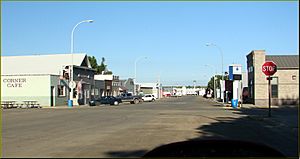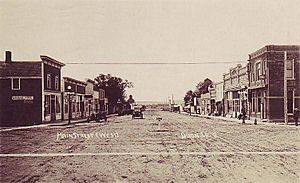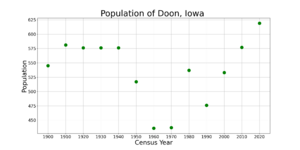Doon, Iowa facts for kids
Quick facts for kids
Doon, Iowa
|
|
|---|---|

Main Street of Doon, Iowa in 2013
|
|

Location of Doon, Iowa
|
|
| Country | United States |
| State | Iowa |
| County | Lyon |
| Incorporated | 1892 |
| Government | |
| • Type | Mayor-council |
| Area | |
| • Total | 0.70 sq mi (1.82 km2) |
| • Land | 0.70 sq mi (1.82 km2) |
| • Water | 0.00 sq mi (0.00 km2) |
| Elevation | 1,296 ft (395 m) |
| Population
(2020)
|
|
| • Total | 619 |
| • Density | 881.77/sq mi (340.59/km2) |
| Time zone | UTC-6 (Central (CST)) |
| • Summer (DST) | UTC-5 (CDT) |
| ZIP code |
51235
|
| Area code(s) | 712 |
| FIPS code | 19-21900 |
| Website | City of Doon |
Doon is a small city in Lyon County, Iowa, in the United States. It is located right next to the Rock River. In 2020, about 619 people lived there. A railway also runs through Doon, which was important for its early growth.
Contents
History of Doon
Doon is built on a flat area of land called a plateau, on the east side of the Rock River. The city got its name from the River Doon in Scotland. This Scottish river is famous from a poem called "The Banks O' Doon" by Robert Burns.
Two people, G. W. Bowers and A. H. Davison, founded Doon on September 6, 1889. It started as a railway town, meaning it grew because of the railroads. First, the Rock Valley Railway came through, and then the Iowa & Dakota Railroad. Doon officially became a city on March 8, 1892.
Geography of Doon
Doon covers an area of about 0.70 square miles (1.82 square kilometers), and all of it is land.
The Rock River flows along the north and west sides of the city. It's a smaller river that eventually joins the Big Sioux River. Another river, the Little Rock River, flows past the south side of Doon and also joins the Rock River nearby.
You can reach Doon by U.S. Route 75, which is about three miles east of the city. Iowa Highway 167 connects Doon to this main road. The Burlington Northern railway also runs along the west side of the city.
Population of Doon
| Historical populations | ||
|---|---|---|
| Year | Pop. | ±% |
| 1900 | 545 | — |
| 1910 | 581 | +6.6% |
| 1920 | 576 | −0.9% |
| 1930 | 576 | +0.0% |
| 1940 | 576 | +0.0% |
| 1950 | 517 | −10.2% |
| 1960 | 436 | −15.7% |
| 1970 | 437 | +0.2% |
| 1980 | 537 | +22.9% |
| 1990 | 476 | −11.4% |
| 2000 | 533 | +12.0% |
| 2010 | 577 | +8.3% |
| 2020 | 619 | +7.3% |
| Source: and Iowa Data Center Source: |
||
In 2020, the city of Doon had 619 people living there. There were 245 households, which are groups of people living together. The population density was about 882 people per square mile (340.6 per square kilometer).
Most people in Doon are White. About 2.9% of the population were Hispanic or Latino. The average age of people in Doon was 32.3 years old. About 33.3% of the residents were under 20 years old.
In 2010, Doon had 577 people. The population has grown a bit since then.
Education in Doon
Students in Doon attend schools that are part of the Central Lyon Community School District.
Famous People from Doon
- Jean Ray Laury, a well-known artist.
- Frederick Manfred, a famous author.
See also
 In Spanish: Doon (Iowa) para niños
In Spanish: Doon (Iowa) para niños



